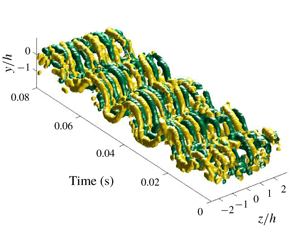Published online by Cambridge University Press: 05 December 2019

The structure of streamwise vortices that arise due to secondary instabilities in the wake of a two-dimensional blunt body with a chord-to-thickness ratio of 12.5 was investigated using high-speed stereoscopic particle image velocimetry. Reynolds numbers spanning an order of magnitude from  $Re(h)=2600$ to 25 800 were considered, where
$Re(h)=2600$ to 25 800 were considered, where  $h$ is the height of the blunt trailing edge. A modified two-dimensional
$h$ is the height of the blunt trailing edge. A modified two-dimensional  $Q$-criterion (
$Q$-criterion ( $Q^{\prime }=\unicode[STIX]{x1D714}_{x}Q/|\unicode[STIX]{x1D714}_{x}|$) was applied to identify the streamwise vortices. The wavelength of the streamwise vortices, defined as the spanwise distance between adjacent streamwise vortex pairs in the wake, was investigated by applying an autocorrelation algorithm to snapshots of
$Q^{\prime }=\unicode[STIX]{x1D714}_{x}Q/|\unicode[STIX]{x1D714}_{x}|$) was applied to identify the streamwise vortices. The wavelength of the streamwise vortices, defined as the spanwise distance between adjacent streamwise vortex pairs in the wake, was investigated by applying an autocorrelation algorithm to snapshots of  $Q^{\prime }$. The most probable wavelength was found to range from
$Q^{\prime }$. The most probable wavelength was found to range from  $0.67h$ to
$0.67h$ to  $0.85h$ with increasing
$0.85h$ with increasing  $Re$, and the mean wavelengths increased from
$Re$, and the mean wavelengths increased from  $0.77h$ to
$0.77h$ to  $0.96h$. These wavelength values appeared to increase asymptotically. Visual inspection and cross-correlation analyses based on
$0.96h$. These wavelength values appeared to increase asymptotically. Visual inspection and cross-correlation analyses based on  $Q^{\prime }$ showed that the streamwise vortices maintain their directions of rotation during primary shedding cycles. The latter analysis was carried out at low
$Q^{\prime }$ showed that the streamwise vortices maintain their directions of rotation during primary shedding cycles. The latter analysis was carried out at low  $Re$ because of a large amount of wake distortion and the absence of time-resolved data at high
$Re$ because of a large amount of wake distortion and the absence of time-resolved data at high  $Re$. The characteristics of the streamwise vortex structure found here match those of mode B, which, at similar
$Re$. The characteristics of the streamwise vortex structure found here match those of mode B, which, at similar  $Re$, dominates the wakes of circular and square cylinders and has also recently been shown to exist in the wake of an elongated blunt body with a larger chord-to-thickness ratio of 46.5 (Gibeau et al., J. Fluid Mech., vol. 846, 2018, pp. 578–604).
$Re$, dominates the wakes of circular and square cylinders and has also recently been shown to exist in the wake of an elongated blunt body with a larger chord-to-thickness ratio of 46.5 (Gibeau et al., J. Fluid Mech., vol. 846, 2018, pp. 578–604).